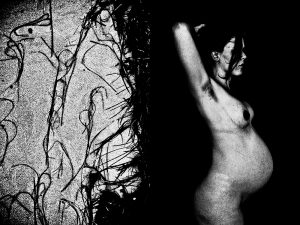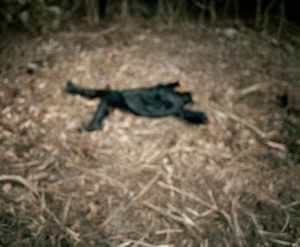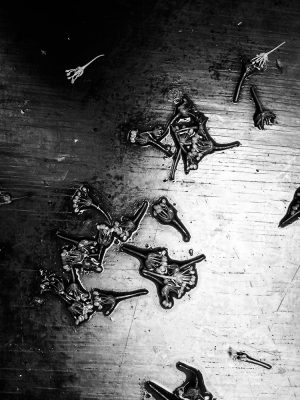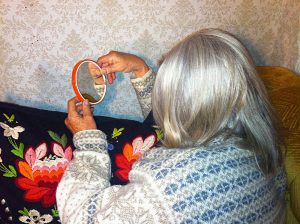Crime fiction has been dominated by male writers, hardboiled detectives, and disillusioned policemen, lone wolves who, using their strong physiques, logical reasoning, and common sense, stand up against the corrupt rulers and violent criminals of modernity and the metropolis. In this regard, Raymond Chandler harboured no doubt whatsoever: the detective in hardboiled crime fiction was a man with a capital M. Accordingly, the women featured assumed the roles of either deferential housewifes, nice secretaries, dead corpses, or as villainous temptresses with a marked anxiety-provoking sexuality.
By the end of the twentieth century, in the slipstream of the 1970s’ battle of the sexes, the stereotypical gender roles of the genre were contested. It was primarily, though not exclusively, female writers who injected crime fiction with a shot of feminism as well as introducing new social settings and lifestyles. While feminist crime fiction appeared in the USA during the 1980s, the so-called Nordic Queens of Crime and their femi-crime novels conquered the bestseller lists of the 1990s and the 2000s.
It was hardly a new phenomenon for women to be writing crime fiction or being featured as amateur detectives – they have done so throughout the history of the genre. Maria Lang (1914-1991) – the first proper Nordic Queen of Crime – introduced amateur sleuth, Puck Ekstedt in the 1950s. She assisted the pipe-smoking Inspector Christer Wijk, who, in line with the conventions of the whodunit, would step in as the male force of law and order, taking action and settling scores.
In feminist-inspired crime fiction, gender roles are often ambivalent or turned upside down. Female writers have extended the social realism and social critique of traditional Nordic crime fiction by focussing on the underlying gender-specific social structures of violence. Men’s violence against women, rape, child abuse, prostitution, and international trafficking constitute recurring themes.
These were also central themes in Stieg Larsson’s (1954-2004) blockbuster Millennium trilogy (2005-2007), which placed Nordic noir firmly on the map. Larsson’s iconic heroine, the goth-hacker, Lisbeth Salander, while victim of systematic sexual abuse, steadfastly refuses to assume the cloak of victimhood so often assigned to women in crime fiction. In a society depicted as thoroughly permeated by misogyny, the sexually ambivalent Salander must resort to violent, financial, and technological vigilantism in order to set herself free and avenge herself and the countless other – silent – victims.
Today, Nordic noir is a diverse genre – not least with regards to the representation of gender, sexuality, and violence. This may seem surprising, yet Nordic noir has become the literary form in which gender issues and social inequality are most directly negotiated with a wide, boundary-crossing audience.
More Than a Mere Crime Novel
Considering the oeuvre of a writer such as Swedish Kerstin Ekman (b. 1933) it became evident that the hitherto rigid genre of crime fiction could be employed to stage complex and unorthodox plots, social settings, and characters in the service of a higher cause – of civilisation and gender critique. Her international breakthrough, Händelser vid vatten (1993; Blackwater, 1996), utilises the crime plot in a literary-ethnological study of the periphery of the Swedish welfare state, the disastrous environmental impact of industrialisation, and the conflicted and – occasionally – violent nature of motherhood.

With the genre-hybrid and postcolonial crime novel, Frøken Smillas fornemmelse for sne (1992; Smilla’s Sense of Snow, 1992; Miss Smilla’s Feeling for Snow, 1993), Peter Høeg (b. 1957) became another contributor to the popularity of a crime genre harbouring social and gender critiques. The protagonist of the novel is Smilla Qaavigag Jaspersen, a maladjusted Greenlandic-Danish glaciologist, who becomes involved in the investigation of the mysterious death of a Greenlandic boy in Copenhagen.
The plot in Høeg’s novel, like in most Nordic femi-crime novels, is subordinate to the focus on Smilla’s reflections and problems with her personal past, identity, the women and men in her life, and society’s inherent structural issues.
Smilla is like a page out of the 1990s book, which considers ethnic-minority and gendered identities as fluid and performative. Other than her feminine traits, she is described in a manner similar to the hardboiled male detective: she is independent and strong-minded in thought and deed and is able to move between various identities at her disposal, e.g. when wearing an expensive sealskin coat and carrying a Louis Vuitton handbag. Smilla is thus related to Salander, though the latter is more determined in her manipulation of (evil) men through the conscious deployment of stereotypical images of women, e.g. when she appears as her upper-class alter ego, Irene Nesser, wearing a wig and breast implants.
Though permanently exiled and alienated, Smilla boasts exceptional social empathy with the most vulnerable in society, offers caustic insights into Danish imperialism, and is – like a modern-day Sherlock Holmes – of a rational, scientific disposition, which, at times, manifests itself as cocky misanthropy: “It’s easier for me to take an interest in mathematics than to feel affection for my fellow human beings.” As a heroine, Smilla is unlucky in love and the subject of unsucessful socialisation, however, with the collapse of the scientific male worldview due to the crime plot, she, too, must re-evaluate her self-imposed exile in the world of numbers.
Ekman’s and Høeg’s ambitious novels dismantled the boundaries between literary novels and popular fiction and achieved, additionally, international success. While their female detectives continue to be coincidental amateur detectives, despite their individual traumas and struggles with culture and identity, as individuals they possess agency and are driven – in their personal life as well as the crime investigations – by a sense of inner necessity and justice rather than by ideals of gender politics.
The Female Avenger
The female detectives, criminals, and victims often resort to vigilantism in order to curtail the tide of psychological, social, and bodily violence which the modern welfare state has been unable to put a stop to.
In Norwegian Unni Lindell’s (b. 1957) Slangebæreren (1996; The Snake Bearer), the first novel in the Cato Isaksen series, the serial killer turns out to be a woman working at a women’s refuge. She grew up with a violent father and inherited the knife eventually used by her mother to kill him. The knife is now used to avenge other women who are victims of violence. The motives of the serial killer are explained neither by means of her psychopathy nor by the childhood failings of her parents. Rather, the focus is on society’s failure to support women who are subjected to violence and a police force, that is reduced to being mere onlookers while destiny and vigilantism rules.

Lindell’s Norwegian colleague, Karin Fossum (b. 1954) made her crime fiction debut with Evas øye (1995; Eva’s Eye, 2013), the first book in an extensive series of psychological suspense novels featuring Inspector Konrad Sejer. He is, unlike the majority of male Nordic noir detectives, a perfectly likeable person and police officer, whose moral compass always points in the right direction. At the forefront, are Fossum’s compassionate and puzzle-like portraits of murderers and their motives, the consequences of crime for those affected as well and the small local communities involved.
In Evas øye, the struggling artist and single mother, Eva Magnus, is compelled to take matters into her own hands. She is – by chance and circumstance – forced into the fateful situation of witnessing the murder of her friend, who is a prostitute. As it happens, her friend’s death affords Eva the opportunity to claim her share of a much-needed legacy. Eva’s detective work also leads her to vigilantism, however, unlike Lindell’s serial killer, she murders the wrong man and is subsequently punished.
Fossum’s crime fiction is untraditional, offering an empathic (female) view on a dehumanised justice system and a cynical society, which allows vulnerable individuals to easily slip through the social safety net. She has emphasised her desire to put the concept of crime – and thereby, the very crime novel – into perspective, by “allowing the reader to form a close bond with someone, who will be driven to commit a severe crime.” (Helene Moe: “Det totale mareridt”. Kristeligt Dagblad, 26.11.2011).
A Detective Story with a Pink Harley-Davidson Motorcycle

In 1993, in the novel, Blind gudinne (2012; Blind Goddess, 2012) by Norwegian Queen of Crime, Anne Holt, inspector Hanne Wilhelmsen drove into the male-dominated police crime drama on a pink Harley-Davidson motorcycle. Outwardly, Wilhelmsen is, as attested to by her choice of vehicle, a feminine as well as a hardboiled investigator. Moreover, she is in a lesbian relationship, which – to her partner’s dismay – she does everything possible to conceal. Wilhelmsen wants to keep her private and professional lives separate, however, the boundary between the two becomes increasingly porous as the series of books progresses. The motif of Wilhemsen’s sexuality is downplayed in the novels, something which sets Holt’s lesbian crime fiction apart from the American tradition. In Nordic noir, the lesbian detective is, nevertheless, remarkably rare.
Wilhelmsen is also the central character in Salige er de som tørster (1994; Blessed Are Those Who Thirst, 2012), which is set in Oslo during a scorching summer where the police are overwhelmed by a series of rapes. Wilhelmsen and her colleagues are, additionally, faced with several bloody crime scenes devoid of corpses and where a mysterious series of numbers appears to be the only clue. The investigation of these so-called ‘Saturday massacres’ is narrated in tandem with a brutal rape case and the traumatic reactions of the victim and her father to the crime.
The series of numbers turn out to be the national identification numbers of female asylum seekers killed – and their bodies subsequently concealed – by a member of the police force. Aside from commenting on the public invisibility of immigrants in Norway, the novel also suggests that the police are incapable of putting a stop to violence against women. Here too, the critique of society’s inherent misogyny and racism culminates in the rape victim taking the law into her own hands – however, there are neither legal nor moral sanctions this time.

Wilhelmsen is a commanding advocate of immigrant rights and this theme leads to the definitive conflation between her public persona and highly-guarded personal life, when, in a subsequent volume, she embarks on a relationship with a Turkish Muslim woman.
The treatment of immigrants in the Nordic countries is not merely a theme in Holt’s writing – perhaps most prominently in her Agatha Christie-pastiche, 1222 (2007; 1222, 2011) – it is a theme shared by several other writers of the genre, e.g. Finnish Queen of Crime, Leena Lehtolainen’s series about Inspector Maria Kallio. In Minne tytöt kadonneet (2010; Where Have All the Young Girls Gone?, 2012) a case concerning missing Muslim girls affords an opportunity to debate controversial issues concerning gender and cultural differences, racism, and ‘honor’ killings. Danish Elsebeth Egholm similarly addressed immigration issues in the novel, Personskade (2005; Personal Injury) from her series of books about the journalist, Dicte, and in Danish Sara Blædel’s Kun et liv (2007; Only One Life, 2007) public debates on ‘honor’ killings and immigration permeate Louise Rick’s investigation of the killing of a Jordanian and a Danish girl.
The feminist crime novel of the 2000s is multifaceted and gender issues constitute but one of many shared characteristics. However, ethical questions are brought to the fore when the gender perspective shifts in hardboiled detective novels and masculine police crime dramas, e.g. the legitimacy of vigilantism in the case of impotent public authorities and society’s lack of empathy for victims of violence and the socially marginalised.
Media Queens of Crime
According to Karl Berglund (2012), the number of female Swedish crime writers rose exponentially around the turn of the millennium and a similar trend was discernible in Norway and Denmark. Norwegian female writers, in particular, had witnessed great success in the Nordic countries during the 1990s. The first Swedish and Danish Queens of Crime were crowned upon the announcement of crime fiction competitions, such as the Swedish Poloni Prize awarded to Liza Marklund (b. 1962) in 1998. In 2002, the Danish crime novel award was won by Gretelise Holm (b. 1946) for Mercedes-Benz Syndromet (1998; The Mercedes-Benz Syndrome). Both writers have subsequently become leading representatives of the femi-crime genre, which has become a constant fixture on the bestseller lists as well as an object of academic interest. (Karl Berglund: Deckarboomen under lupp: statistiska perspektiv på svensk kriminallitteratur 1977-2010. Avdelingen för Litteratursociologi, 2012)
The femi-crime novel is a subgenre consisting chiefly of crime novels written by female writers, with female detectives, and with plots, which, in the words of Karen Klitgaard Povlsen (1995), “oscillate between issues pertaining to the constellation constituted by gender, love, work, and death”. While the designation of this subgenre is not widely used in international literary research, it has, however, been employed in the Nordic countries in order to highlight the critical – and marketing – potential of crime novels written by women. Today, the femi-crime brand would seem too narrow to include a rambunctious and diverse group of female writers who have – in turns – been crowned as the bestselling Queen of Crime in the Nordic countries. Marklund, whose novels have often been designated as femi-crime, is not terribly keen on the moniker, which she considers sexist. (Karen Klitgaard Povlsen: “Dødskys. Kvindelige detektiver hos Marcia Muller og Sara Paretsky”. Den sidste gode genre: Krimiens aktualitet. Klim, 1995)
The arrival of femi-crime on the bestseller lists did not occur without a gender struggle. During the ‘femi-crime feud’ of the summer of 2007, some male writers publicly attacked the bestselling Queens of Crime in Sweden. Camillla Läckberg, in particular, was accused of writing romantic chick-lit novels rather than crime fiction, and female femi-crime writers were – due to their interest in everyday realism at the expense of crime plot – pigeonholed as writers of failed crime fiction.
Writers such as Läckberg, Egholm, and Blædel were successfully promoted in the media and some of their novels were distributed with glossy lifestyle magazines. Läckberg was particularly adept at exploiting the internet in the promotion of her work, engaging her fan base in the development of her crime series, and spiking interest in her private life. Marklund, too, was able to transgress the boundaries delimiting author and fiction, most noticeably by appearing on the front covers of her crime novels.
Ulrik Lehrmann (2011) has pointed out that some of the Queens of Crime, debuting around the turn of the millennium, have been able to raise their profile in the new media culture due to their professional background in media and journalism, e.g. Marklund, Mari Jungstedt (b. 1962), Egholm, Blædel, Holm, and Kjersti Scheen (b. 1943). They incorporate themes – and in some case, stories already reported in the media – in their crime fiction and their writing styles evoke genres and styles from print media and cinematic narratives.
While female crime writers at the turn of the millennium achieved well-nigh equal representation on the bestseller lists, the femi-crime novel continues – like public debates in the media – to be characterised by the general theme of gender inequality. The Queens of Crime’s offering of novels informed by contemporary social critique is designed – in style as well as content – to create a current fictional space in which to examine the multifaceted gender issues in a new media reality.
An Explosive Crime Novel
Marklund’s debut novel, Sprängaren (1998; The Bomber, 2001) follows Annika Bengtzon, a successful and leading journalist at the crime desk of the tabloid newspaper, Kvällspressen, and her conflicts with male and female colleagues, who are constantly attempting to undermine her authority. Throughout the novel, it becomes evident how women have yet to achieve equality in the labour market; to be a woman in a leadership position equals – Marklund specifies – disadvantage.
In Sprängaren, Annika is reporting on a presumed terrorist attack at the Olympic stadium in Stockholm. However, it soon becomes apparent that the bombs are motivated by personal issues and it turns out that the first victim and the executioner are both women. Annika suffers from feelings of inadequacy on the home front, in relation to her husband and children, due to her professional success. It is difficult for her to live up to maternal ideals, which demand the ability to bake Christmas biscuits with the children while also handling a taxing career. However, at the newspaper, she gives short thrift to colleagues who do not drop everything in pursuit of a story.
The novel has a parallel narrative consisting of the personal jottings of bomb victim, Christina Furhage, director of the organising committee of the Olympic Games, who contemplates the banality of love and the true love of work. In private, she was a defeminised woman, unable to figure out whether she was a man or a woman, transgressing the laws of heteronormativity, and in a relationship with a militant lesbian colleague. Furhage knew with certainty one thing only about herself; that she was a human being – which is, incidentally, also the first definition Annika ascribes to herself, before identifying as mother and wife. In the text, these jottings of Furhage function as a radical commentary to Annika’s own personal experiences.

Annika and Furhage also share the fate of being targeted by the murderer, Beate Ekesjö, inasmuch as they have both been guilty of thwarting her career ambitions and desire for professional visibility. Annika’s professional and private life is reflected in and similar to victim and executioner alike: the minutiae of everyday conflicts are exposed within the grand and violent narrative of the crime story. Throughout the series, readers gain insights into Annika’s ruined emotional and family life in a constant flux between incongruous gender roles.
While Marklund’s feminist crime novel emphasises the necessity of empathising with the pressures women are subjected to by career demands and the media, Annika is by no means liberated from those very demons women are forced to contend with in order to achieve human subjecthood.
One Big Family
Läckberg’s protagonist, Erica Falck, on the contrary, has fewer demons to fight despite many worries concerning her immediate family and the idyllic, but violent, village of Fjällbacka. In Isprinsessan (2003; The Ice Princess, 2010), she finds her childhood friend brutally murdered and becomes involved with the police officer, Patrick, whose investigations reveal a prosperous family’s attempts at covering up paedophilia as well as a whole range of other attempts at concealing the past in this small-town community.
Parallel to the crime investigation, we follow the private life and worries of Erica, primarily in the guise of her sister who is in an abusive relationship. We also follow the early days of her own relationship with Patrick, whom she marries and raises a family with in the subsequent volumes of the series. The characters in Läckberg’s debut novel are painted with a melodramatic brush. The men are either male chauvinist Neanderthals or decidedly wonderful and sensitive, and unlike feminist crime novels – though not dissimilar to other femi-crime books – Erica’s negotiations of gender roles are considerably more cliché-ridden, leaving her husband to do the detective work when she – though peeved – assumes her role as mother and wife. However, the family is nevertheless treated as a complex community with subtle boundaries between snug and stifling protectiveness – here, like in Ekman, a mother who kills in order to protect her son against the condemnation of the outside world.

The feminist crime novel has scrutinised gender roles in the workplace and romantic relationships after the advent of the women’s rights movement as representative microcosms of gender-based inequalities, conflicts, and violence in society. In Danish Sissel-Jo Gazan’s (b. 1973) scientific suspense novel, Dinosaurens fjer (2008; The Dinosaur Feather, 2012), the onus is on the institution of the family and its inherent lies. Here, hardboiled student and single mother, Anna Bella, not only unearths an academic feud concerning the possible relation between birds and dinosaurs, the macabre murders of her academic supervisor and a fellow student – she also uncovers her own personal story of childhood abandonment. Unmasking the suppression of her own childhood is a prerequisite to Anna’s reconciliation with her own maternal role and the man, who abandoned her.
The novel’s other families in crisis repress and demonise infidelity, homosexuality, and alternative lifestyles – resulting at times in violence and death. Just like the necessity for exhumation of the bones of birds in order to scientifically confirm their origins, the family skeletons, too, must be brought out in the open in order for forgiveness and acceptance of the past to occur. A similar constellation of scientific suspense, transgressive sexuality, interred family histories, and the worries of a resourceful single mother constituted the springboard for the debut novel, Þriðja táknið (2005; Last Rituals, 2007) from Icelandic Queen of Crime, Yrsa Sigurðardóttir.
The Facelift of Femi-Crime
Susanne Staun is possibly the most headstrong and hardboiled voice in Nordic crime fiction. She believes that unless the femi-crime novel “undergoes a tremendous facelift, the trend will die of natural causes”. The facelift proposed by Staun consists of her very own postfeminist expert profiler, Fanny Fiske, whose specialty is serial killers. Besides her incomparable analytical capabilities and advocacy of the death penalty in a future European superstate, Fiske is also a major consumer of men, expensive clothes, and fine foods. And she remains unapologetic about her hedonism, though she is decried as a nymphomaniac by the press. (Charlotte Sejer Pedersen: “Susanne Staun: En hot dog med det hele”. Politiken, 15.08.2007)
Fiske also remains unconcerned by retro-feminists’ critique of her decided use of plastic surgery. She describes herself as a lipstick feminist and “has had four facelifts and several rounds of laser resurfacing” in addition to a brow lift and other treatments because, as she says: “It is bad enough that we will, eventually, all die, however, as a desirable woman, one doesn’t have to put up with such a pitifully short shelf life.” (Liebe; 2002).
Fiske’s dark view of death, the body, and evil, and the negative legacy of the family, in particular, is quite a long way off the aspirations of the femi-crime novel, whose sympathetic and moral detective eventually – despite her flaws and shortcomings – reconciles herself with her gender role and witnesses justice be served. Fiske has been sterilised by choice and now pursues pleasure as a distraction from the fear of ageing and death, which she avenges by capturing evil serial killers. Staun’s universe is a dystopian vision of the future in a morally bankrupt Europe – it is a novel, which takes the feminist crime novel’s depiction of dysfunctional families, ambivalent gender roles, and the lack of social repercussions for men’s exercise of violence against women to its logical extreme.
A Faroese Sweater and an Old Porsche
Female writers have not merely challenged their male counterparts on the Nordic bestseller lists, they have also imbued their female detectives with traditionally masculine traits, appearing as self-sacrificing, hardboiled, and obsessive professionals, who are intimately familiar with all aspects of life in the big city. The female heroines of the hard-boiled school of crime, in particular, have reached cult status beyond the Nordic countries – especially thanks to television series such as Søren Sveistrup’s Forbrydelsen (The Killing; 2007, 2009, 2012) and Hans Rosenfeldt’s Broen/Bron (The Bridge; 2011, 2013, 2015).

In the United Kingdom, Forbrydelsen reached impressive average ratings of close to one million and viewers were extraordinarily preoccupied with Sarah Lund and her Faroese sweater. She became a new feminist icon: an edgy but determined woman who made short thrift of the one-sided image of women in a visually-oriented popular culture. Underneath the protective armour of Faroese knitwear, Lund is a courageous, taciturn woman who favours a greater cause above and beyond the well-being of herself and her family. It is thus no surprise that she experiences problems in her roles as colleague, partner, daughter, and single mother.
The portrayal of Saga Norén in Broen/Bron is less social-realist than the depiction of Lund in Forbrydelsen. She is, on the one hand, a sexy, hardboiled action heroine sporting leather trousers and a green Porsche, a dedicated and moral investigator. On the other hand, however, she is socially dysfunctional in her dealings with colleagues and apparently completely lacking in empathy. In the second series, it is suggested that she may perhaps suffer from hereditary illness and family trauma.
The hardboiled detectives of the television series, who might very well have leapt straight from the pages of feminist crime novels and onto the television screens, may be considered as a manifestation of the conclusion of gender struggles and the diminishment of traditional gender roles during a period in time in which the individual is constituted by the role assumed. However, they may also be viewed as alternative images of women who – as opposed to the self-absorbed and consumer-oriented lipstick postfeminists exposed in media culture – turn a blind eye to the male gaze and sacrifice themselves for a greater ethical cause.
The character of Sarah Lund achieved cult status precisely as a form of counter-image – not least beyond the Nordic countries – as illustrated by her guest appearance in the 2011 Christmas special of Jennifer Saunders’ Absolutely Fabulous, one of the greatest British sitcom successes and a camp satire of the decade’s fashion, lifestyle, and media world (1992-1996, 2011). In this episode, Edina Monsoon dreams that she awakens to find the aloof detective – dressed in her iconic sweater – investigating her bedroom as if it were a crime scene.
In the juxtaposition of these female characters as two extremes of popular culture, the Nordic female detective represents a feminist alternative to the character of Edina, the body- and glamour-obsessed media culture, and the hedonistic individualism of the 1990s. Edina believing herself capable of speaking Danish after watching one series of Forbrydelsen – only to be coldly told off by Lund – is a testament to the surprising desirability of the image of womanhood invoked by Lund and the international accomplishments of Nordic noir as a small part of a wider international interest in austere ‘Nordic’ values and egalitarian gender politics in the globalised era of environmental and financial crises.
- Sara Blædel: Kun et liv. Lindhardt og Ringhof, 2007. Only One Life, Pegasus Crime, 2007
- Elsebeth Egholm: Personskade. Gyldendal, 2005
- Kerstin Ekman: Händelser vid vatten. Bonnier, 1993. Blackwater. Doubleday, 1996
- Karin Fossum: Evas øye. Cappelen Damm, 1995. Eva’s Eye. Houghton Mifflin Harcourt, 2013
- Sissel-Jo Gazan: Dinosaurens fjer. Gyldendal, 2008. The Dinosaur Feather, Riverrun, 2012
- Anne Holt: Blind gudinne. Cappelen Damm, 1993. Blind Goddess. Scribner, 2012
- Anne Holt: Salige er de som tørster. Cappelen Damm, 1994. Blessed Are Those Who Thirst, Scribner, 2012
- Anne Holt: 1222. Piratforläget, 2007. 1222, Corvus, 2011
- Peter Høeg: Frøken Smillas fornemmelse for sne. Rosinante, 1992. Smilla’s Sense of Snow, Delta, 1992. Miss Smilla’s Feeling for Snow, Harvill, 1993
- Leena Lehtolainen: Minne tytöt kadonneet. Bazar, 2010. Where Have All the Young Girls Gone?, Tammi, 2010
- Unni Lindell: Slangebæreren. Aschehoug, 1996.
- Camilla Läckberg: Isprinsessan. Forum, 2003. The Ice Prinsess, Pegasus, 2010
- Liza Marklund: Sprängaren. Ordupplaget, 1998. The Bomber, Simon & Schuster, 2001
- Hans Rosenfeldt: Broen/Bron. Nimbus Film, 2011, 2013, 2015
-
Yrsa Sigurðardóttir, Þriðja táknið. Forlagið, 2005. Last Rituals. William Morrow, 2007
Susanne Staun: Liebe. Gyldendal, 2000
Søren Sveistrup: Forbrydelsen. DR, 2007, 2009, 2012 -
Non-Fiction
Fiction
- Gunhild Agger og Anne Marit Waade (red.): Den skandinaviske krimi: bestseller og blockbuster. Nordicom, 2010
- Frank Egholm Andersen: Den nordiske femikrimi: Læbestiftslitteratur eller fornyelse af en genre. Her & Nu, 2008
- Karl Berglund: Deckarboomen under lupp: statistiska perspektiv på svensk kriminallitteratur 1977-2010. Avdelingen för Litteratursociologi, 2012
- Kerstin Bergman: Swedish Crime Fiction: The Making of Nordic Noir. Mimesis International, 2014
- Kerstin Bergman og Sara Kärrholm: Kriminallitteratur: utveckling, genrer, perspektiv. Studentlitteratur, 2011
- Barry Forshaw: Death in a Cold Climate: A Guide to Scandinavian Crime Fiction. Palgrave Macmillan 2012
- Karen Klitgaard Povlsen: ”Dødskys. Kvindelige detektiver hos Marcia Muller og Sara Paretsky”. Den sidste gode genre: Krimiens aktualitet, René Rasmussen og Anders Lykke (red.). Klim, 1995
- Sara Kärrholm: Konsten att lägga pussel: Deckaren och besvärjandet av ondskan i folkhemmet. Symposion, 2005
- Ulrik Lehrmann: ”Spor af mord og medier – litteraturens medialisering”. Kritik 201, 2011
- Helene Moe: ”Det totale mareridt”. Kristeligt Dagblad, 26.11.2001
- Sally R. Munt: Murder by the Book? Feminism and the Crime Novel. Routledge, 1994
- Andrew Nestingen og Paula Arvas (red.): Scandinavian Crime Fiction. University of Wales Press, 2011
- Charlotte Sejer Pedersen: ”Susanne Staun: En hot dog med det hele”. Politiken, 15.08.2007
- Gill Plain: Twentieth-Century Crime Fiction: Gender, Sexuality and the Body. Psychology Press, 2001
- Hans H. Skei: Blodig alvor: om kriminallitteraturen. Aschehoug, 2008
- Jakob Stougaard-Nielsen: Scandinavian Crime Fiction. Nordicom, 2016
- Heather Worthington: Key Concepts in Crime Fiction. Palgrave Macmillan, 2011

